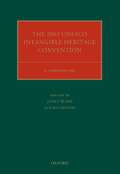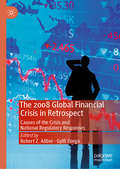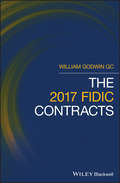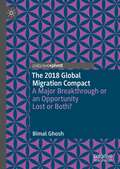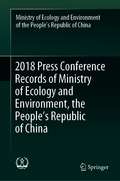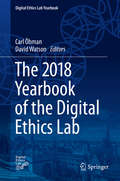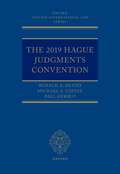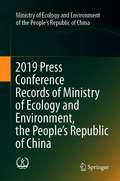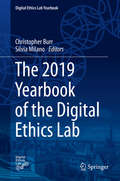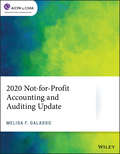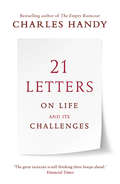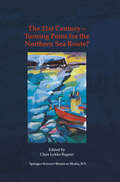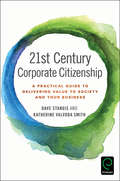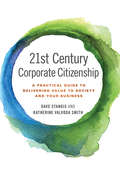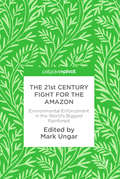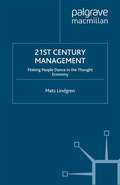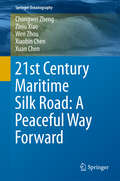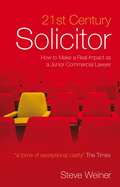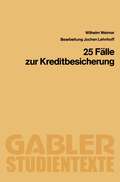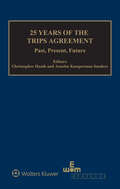- Table View
- List View
The 2003 UNESCO Intangible Heritage Convention: A Commentary (Oxford Commentaries on International Cultural Heritage Law)
by JANET BLAKE, LUCAS LIXINSKIThis book critically analyses the 2003 Convention for the Safeguarding of the Intangible Cultural Heritage, UNESCO's latest and ground-breaking treaty in the area of cultural heritage protection. Intangible cultural heritage is broadly understood as the social processes that inform our living cultures, and our social cohesion and identity as communities and peoples. On the basis of this conception, the Treaty proposes to turn our understanding of how, for whom, and why heritage is safeguarded on its head, by putting communities, groups and individuals at the centre of the safeguarding process. The commentary, written by leading experts in the field from all continents and multiple disciplines, provides an authoritative guide to interpreting and implementing not only this Treaty, but also its ripple effects on how we think about cultural heritage and our experience with it as a part of our living cultures. This book is of interest to lawyers, policy-makers, anthropologists, cultural diplomacy specialists, archaeologists, cultural heritage studies experts, and, foremost, the people who practice and enact this heritage.
The 2003 UNESCO Intangible Heritage Convention: A Commentary (Oxford Commentaries on International Cultural Heritage Law)
This book critically analyses the 2003 Convention for the Safeguarding of the Intangible Cultural Heritage, UNESCO's latest and ground-breaking treaty in the area of cultural heritage protection. Intangible cultural heritage is broadly understood as the social processes that inform our living cultures, and our social cohesion and identity as communities and peoples. On the basis of this conception, the Treaty proposes to turn our understanding of how, for whom, and why heritage is safeguarded on its head, by putting communities, groups and individuals at the centre of the safeguarding process. The commentary, written by leading experts in the field from all continents and multiple disciplines, provides an authoritative guide to interpreting and implementing not only this Treaty, but also its ripple effects on how we think about cultural heritage and our experience with it as a part of our living cultures. This book is of interest to lawyers, policy-makers, anthropologists, cultural diplomacy specialists, archaeologists, cultural heritage studies experts, and, foremost, the people who practice and enact this heritage.
The 2008 Global Financial Crisis in Retrospect: Causes of the Crisis and National Regulatory Responses
by Robert Z. Aliber Gylfi ZoegaThis book addresses the causes and consequences of the international financial crisis of 2008. A range of esteemed contributors explore developments in the United States, where the crisis of 2008 originated, as well as the smallest country affected, Iceland, by evaluating developments since 2008. Currently, many countries are facing similar problems as Iceland did in 2008: this book is of interest to economists and policy makers in these countries to study what happened in Iceland, and why the recovery of that economy was strong and swift. The chapters in this book originate from panel discussions and conferences and explore areas including regulation, state projects and inflation.
The 2017 FIDIC Contracts
by William GodwinProvides a clear and comprehensive guide to the 2017 FIDIC contracts—written by a member of the FIDIC Updates Task Group FIDIC contracts are the most widely used engineering standard form contracts internationally but until 2017 the three main forms (the Red, Yellow and Silver Books) had not been amended or updated for nearly two decades, since the first editions were published in 1999. Written by a specialist lawyer who was member of the FIDIC Updates Task Group responsible for writing the new contracts, this book examines in detail the many substantial changes they have introduced. After providing an overview the contracts are examined clause by clause with the aim of showing how each compares and contrasts with the others and how the second editions compare and contrast with the first. The first chapter describes how the Red, Yellow and Silver Books evolved from earlier contract forms and the distinctive characteristics of each, before providing an overview of the updates, including new potential risks for both Employer and Contractor, and then examining, in the second chapter, key general provisions such as the new rules on notices and limitation of liability. Chapter 3 examines the enhanced role of the Engineer in the Red and Yellow Books/Employer’s Representative’s function in the Silver including the new procedure for determinations as well as the Employer’s obligations and contract administration. The Contractor’s obligations are considered in chapter 4 while chapter 5 examines his responsibility for design in the Yellow and Silver Books. Chapters 6 to 14 deal respectively with plant, materials and workmanship and staff and labour; time-related provisions in the three contracts including extensions of time, and the Employer’s right to suspend the works; testing on and after completion and the Employer’s taking over of the works; defects after taking over, acceptance of the works and unfulfilled obligations; measurement (in the Red Book), the Contract Price and payment; the new variations regime and adjustments to the Price; termination and suspension; care of the works and indemnities and Exceptional Events (previously, Force Majeure). An important feature of the new contracts is their increased emphasis on clarity in the claims process and on dispute avoidance. These topics are examined in the final two chapters, 15 and 16, which deal respectively with the new claims and dispute resolution provisions of the 2017 forms. FIDIC contracts are the most widely used standard forms of contract for international engineering and construction projects Provides a clear and comprehensive guide to the 2017 FIDIC Red, Yellow and Silver Books Written by a senior specialist lawyer and member of the FIDIC 2017 Updates Task Group responsible for writing the new contracts Accessible to those with little or no familiarity with FIDIC contracts The 2017 FIDIC Contracts is an important guide for anyone engaged in international projects, including employers, contractors, engineers, lawyers, suppliers and project financiers/sponsors.
The 2017 FIDIC Contracts
by William GodwinProvides a clear and comprehensive guide to the 2017 FIDIC contracts—written by a member of the FIDIC Updates Task Group FIDIC contracts are the most widely used engineering standard form contracts internationally but until 2017 the three main forms (the Red, Yellow and Silver Books) had not been amended or updated for nearly two decades, since the first editions were published in 1999. Written by a specialist lawyer who was member of the FIDIC Updates Task Group responsible for writing the new contracts, this book examines in detail the many substantial changes they have introduced. After providing an overview the contracts are examined clause by clause with the aim of showing how each compares and contrasts with the others and how the second editions compare and contrast with the first. The first chapter describes how the Red, Yellow and Silver Books evolved from earlier contract forms and the distinctive characteristics of each, before providing an overview of the updates, including new potential risks for both Employer and Contractor, and then examining, in the second chapter, key general provisions such as the new rules on notices and limitation of liability. Chapter 3 examines the enhanced role of the Engineer in the Red and Yellow Books/Employer’s Representative’s function in the Silver including the new procedure for determinations as well as the Employer’s obligations and contract administration. The Contractor’s obligations are considered in chapter 4 while chapter 5 examines his responsibility for design in the Yellow and Silver Books. Chapters 6 to 14 deal respectively with plant, materials and workmanship and staff and labour; time-related provisions in the three contracts including extensions of time, and the Employer’s right to suspend the works; testing on and after completion and the Employer’s taking over of the works; defects after taking over, acceptance of the works and unfulfilled obligations; measurement (in the Red Book), the Contract Price and payment; the new variations regime and adjustments to the Price; termination and suspension; care of the works and indemnities and Exceptional Events (previously, Force Majeure). An important feature of the new contracts is their increased emphasis on clarity in the claims process and on dispute avoidance. These topics are examined in the final two chapters, 15 and 16, which deal respectively with the new claims and dispute resolution provisions of the 2017 forms. FIDIC contracts are the most widely used standard forms of contract for international engineering and construction projects Provides a clear and comprehensive guide to the 2017 FIDIC Red, Yellow and Silver Books Written by a senior specialist lawyer and member of the FIDIC 2017 Updates Task Group responsible for writing the new contracts Accessible to those with little or no familiarity with FIDIC contracts The 2017 FIDIC Contracts is an important guide for anyone engaged in international projects, including employers, contractors, engineers, lawyers, suppliers and project financiers/sponsors.
The 2018 Global Migration Compact: A Major Breakthrough or an Opportunity Lost or Both?
by Bimal GhoshThis book analyses the 2018 Global Compact on Migration and the need for, and difficulties of adopting a multilateral agreement on migration. Particular attention is given to the challenges and constraints involved, given not only the divergent needs and conditions of different counties but also the varying interests of different groups within countries. A synoptic history of previous attempts at reaching a multilateral migration agreement is provided, from 1927 onwards, to give context to the recent negotiations. The lack of a clear recognition of migration as a global process and the absence of a firm commitment to responsibility- sharing arrangements are highlighted. The book explains why the 2018 migration is both a breakthrough and at the same time an opportunity lost. In doing so,] it also analyses the limitations of the present deal, including inadequate attention to the root causes of forced and disruptive migration in origin countries, and highlights how the 2018 agreement can be built upon to create a dynamic harmony in the global migration system. The book will be relevant to researchers and policy makers as well as to professionals and activists concerned with migration, labour economics and international development.
2018 Press Conference Records of Ministry of Ecology and Environment, the People’s Republic of China
by Mini Eco Environ People's Repub ChinaThis book introduces readers to the press release work carried out by Ministry of Ecology and Environment of the People’s Republic of China in 2018. It is divided into 3 parts, and each part is arranged in chronological order. The first part contains the records of Li Ganjie, Minister of the Ministry of Ecology and Environment, who attended the press conference of the two conferences and the “Ministerial Channel”. The second part contains the record of Special Representative of China's Climate Change Affairs, Xie Zhenhua, who attended the “China's Policies and Actions on Climate Change 2018 Annual Report” press conference, and Zhao Yingmin, Deputy Minister of the Ministry of Ecology and Environment, who attended the “Three-year Action Plan to Win the Blue Sky Defense War” policy briefing. The third part contains the records of 12 regular press conferences of the Ministry of Ecology and Environment throughout the year.
The 2018 Yearbook of the Digital Ethics Lab (Digital Ethics Lab Yearbook #1)
by Carl Öhman David WatsonThis book explores a wide range of topics in digital ethics. It features 11 chapters that analyze the opportunities and the ethical challenges posed by digital innovation, delineate new approaches to solve them, and offer concrete guidance to harness the potential for good of digital technologies. The contributors are all members of the Digital Ethics Lab (the DELab), a research environment that draws on a wide range of academic traditions.The chapters highlight the inherently multidisciplinary nature of the subject, which cannot be separated from the epistemological foundations of the technologies themselves or the political implications of the requisite reforms. Coverage illustrates the importance of expert knowledge in the project of designing new reforms and political systems for the digital age. The contributions also show how this task requires a deep self-understanding of who we are as individuals and as a species.The questions raised here have ancient -- perhaps even timeless -- roots. The phenomena they address may be new. But, the contributors examine the fundamental concepts that undergird them: good and evil, justice and truth. Indeed, every epoch has its great challenges. The role of philosophy must be to redefine the meaning of these concepts in light of the particular challenges it faces. This is true also for the digital age. This book takes an important step towards redefining and re-implementing fundamental ethical concepts to this new era.
The 2019 Hague Judgments Convention
by Ronald A. Brand Michael S. Coffee Paul HerrupDeclared a 'game-changer' by the Hague Conference Secretary General, the 2019 Hague Convention on the Recognition and Enforcement of Foreign Judgments in Civil or Commercial Matters has introduced international obligations of unprecedented sweep and power. Now, this authoritative treatise provides the diplomatic background and the historical context for the Convention, discussing the law on judgments recognition in the absence of the Convention's ratification. After recounting the twenty-seven-year history of the negotiations leading to the Convention's conclusion, it offers an article-by-article discussion of each provision. It also considers paths not taken, advancing possible solutions to address future pressures and developments. Authored by experts directly involved in the Convention's drafting, this volume is designed to be an indispensable source for lawyers, judges, and legislators in the adoption, implementation, and use of the 2019 Hague Judgments Convention. Readers will be left with a clearer understanding of the purpose behind each provision, any differences that might have led to compromise in the Convention's language, and the positions stated by national delegations during the negotiations.
The 2019 Hague Judgments Convention
by Ronald A. Brand Michael S. Coffee Paul HerrupDeclared a 'game-changer' by the Hague Conference Secretary General, the 2019 Hague Convention on the Recognition and Enforcement of Foreign Judgments in Civil or Commercial Matters has introduced international obligations of unprecedented sweep and power. Now, this authoritative treatise provides the diplomatic background and the historical context for the Convention, discussing the law on judgments recognition in the absence of the Convention's ratification. After recounting the twenty-seven-year history of the negotiations leading to the Convention's conclusion, it offers an article-by-article discussion of each provision. It also considers paths not taken, advancing possible solutions to address future pressures and developments. Authored by experts directly involved in the Convention's drafting, this volume is designed to be an indispensable source for lawyers, judges, and legislators in the adoption, implementation, and use of the 2019 Hague Judgments Convention. Readers will be left with a clearer understanding of the purpose behind each provision, any differences that might have led to compromise in the Convention's language, and the positions stated by national delegations during the negotiations.
2019 Press Conference Records of Ministry of Ecology and Environment, the People’s Republic of China
by Mini Eco Environ People's Repub ChinaThis book introduces the press release work carried out by Ministry of Ecology and Environment of the People’s Republic of China in 2019. It is divided into four parts, each arranged chronologically. The first part contains the records of Li Ganjie, Minister of the Ministry of Ecology and Environment, who attended the press conference on "Promoting Ecological Civilization and Building a Beautiful China". The second part contains the records of Minister Li Ganjie's attendance at the press conference of the National People's Congress and the Chinese Political Consultative Conference as well as the "Minister channel". The third part contains the records of four press conferences on ecological and environmental protection held by the State Council Information Office of the People's Republic of China. The fourth part contains the records of 12 regular press conferences held by the Ministry of Ecology and Environment.
The 2019 Yearbook of the Digital Ethics Lab (Digital Ethics Lab Yearbook)
by Christopher Burr Silvia MilanoThis edited volume presents an overview of cutting-edge research areas within digital ethics as defined by the Digital Ethics Lab of the University of Oxford. It identifies new challenges and opportunities of influence in setting the research agenda in the field.The yearbook presents research on the following topics: conceptual metaphor theory, cybersecurity governance, cyber conflicts, anthropomorphism in AI, digital technologies for mental healthcare, data ethics in the asylum process, AI’s legitimacy and democratic deficit, digital afterlife industry, automatic prayer bots, foresight analysis and the future of AI. This volume appeals to students, researchers and professionals.
2020 Not-for-Profit Accounting and Auditing Update (AICPA)
by Melisa F. GalassoLearn the latest accounting and auditing developments affecting not-for-profits so that accountants, auditors, and financial managers can prepare financial statements with confidence. This work covers new FASB requirements and information on the latest OMB and Yellow Book developments. It features major program determination and case studies related to revenue recognition and auditing documentation and covers hot topics including: NFP financial statements Risk assessment Documentation Leases Yellow Book Major program determination Key changes GASB updates including GASB Statement No. 91, Conduit Debt Obligations AICPA activities including changes to the auditor's report FASB updates including revenue recognition, grants and contracts, updating the definition of collections, and implementation issue surrounding the financial reporting standard Federal government activities including updates to the Compliance Supplement and proposed changes to the Uniform Guidance
2020 Not-for-Profit Accounting and Auditing Update (AICPA)
by Melisa F. GalassoLearn the latest accounting and auditing developments affecting not-for-profits so that accountants, auditors, and financial managers can prepare financial statements with confidence. This work covers new FASB requirements and information on the latest OMB and Yellow Book developments. It features major program determination and case studies related to revenue recognition and auditing documentation and covers hot topics including: NFP financial statements Risk assessment Documentation Leases Yellow Book Major program determination Key changes GASB updates including GASB Statement No. 91, Conduit Debt Obligations AICPA activities including changes to the auditor's report FASB updates including revenue recognition, grants and contracts, updating the definition of collections, and implementation issue surrounding the financial reporting standard Federal government activities including updates to the Compliance Supplement and proposed changes to the Uniform Guidance
21 Letters on Life and Its Challenges
by Charles HandyCharles Handy is one of the giants of contemporary thought. His books on management – including Understanding Organizations and Gods of Management – have changed the way we view business. His work on broader issues and trends – such as Beyond Certainty and The Second Curve – has changed the way we view society.In his new book, Handy builds on a life's work to glimpse into the future and see what challenges and opportunities the next generation faces. How will people cope with change in a world where the old certainties no longer apply? What goals will and should they set themselves? How will they find purpose and fulfilment in their lives? Clear-eyed and optimistic by turns, he sets out the questions that everyone needs to ask themselves, and points us in the direction of the answers.
The 21st Century — Turning Point for the Northern Sea Route?: Proceedings of the Northern Sea Route User Conference, Oslo, 18–20 November 1999
by Claes Lykke Ragnerby Claes Lykke Ragner, The Fridtjof Nansen Institute Marking the end of the International Northern Sea Route Programme (INSROP), the Northern Sea Route User Conference was organized in Oslo on 18-20 November 1999. The purpose of the Conference was two-fold. First, it was the intention of the organizers to present to the potential users of the Northern Sea Route - i. e. the international shipping industry and relevant cargo owners - the results of six years of multidisciplinary INSROP research. Second, it was the organizers' intention to create a unique meeting place for the different Northern Sea Route stakeholders - a forum where users, the Russian NSR administrators, the researchers and other interested parties could discuss the status and future of the route. In these Conference Proceedings, you will fmd the manuscripts of the speeches presented during the Conference: The manuscripts can roughly be divided into three groups with widely different focuses: On one hand, you will fmd the representatives of shipping and other commercial interests, focusing on the NSR's potential for profit in the short term, and on the shortcomings of the route. On the other hand, you will fmd representatives of different levels of Russian authorities, presenting the possibilities offered by the route, and emphasizing Russia's long experience in using and administrating it. In between these two groups stand the researchers, presenting a multi-faceted and hopefully balanced picture of the NSR and its possibilities vs.
21st Century Corporate Citizenship: A Practical Guide to Delivering Value to Society and your Business
by Dave Stangis Katherine Valvoda Smith21st Century Corporate Citizenship is a practical guide to building a successful business in the modern day. It is a book about leveraging all the tools, trends and assets at the disposal of business to drive bottom-line results, value chain resiliency, productivity, innovation, long-term shareowner value, and benefit for the community. This is the book that leverages corporate citizenship as a value-creating enterprise and translates sustainability, corporate responsibility, and social impact to help you create the most successful business possible in tomorrow’s competitive landscape. For the up and coming manager, this book is the crib sheet to the 21st century MBA that you can’t get (yet) in business schools. The tools and insights presented are valuable for every business person thinking about how to differentiate their company and maximize business and social value—from the sole proprietor to those working in a global megacorporation—the concepts explored are ‘must do’ for those working for manufacturing B2B or B2C companies that are managing complex supply chains, global operations, and corporate reputation. This ‘how-to’ handbook presents a step-by-step process aimed at helping you create the most successful business possible in the 21st century competitive landscape, empowering corporate citizenship professionals to accelerate their credibility within their company as an effective contributor who understands their company’s strategy and who creates value.
21st Century Corporate Citizenship: A Practical Guide to Delivering Value to Society and your Business
by Dave Stangis Katherine Valvoda Smith21st Century Corporate Citizenship is a practical guide to building a successful business in the modern day. It is a book about leveraging all the tools, trends and assets at the disposal of business to drive bottom-line results, value chain resiliency, productivity, innovation, long-term shareowner value, and benefit for the community. This is the book that leverages corporate citizenship as a value-creating enterprise and translates sustainability, corporate responsibility, and social impact to help you create the most successful business possible in tomorrow’s competitive landscape. For the up and coming manager, this book is the crib sheet to the 21st century MBA that you can’t get (yet) in business schools. The tools and insights presented are valuable for every business person thinking about how to differentiate their company and maximize business and social value—from the sole proprietor to those working in a global megacorporation—the concepts explored are ‘must do’ for those working for manufacturing B2B or B2C companies that are managing complex supply chains, global operations, and corporate reputation. This ‘how-to’ handbook presents a step-by-step process aimed at helping you create the most successful business possible in the 21st century competitive landscape, empowering corporate citizenship professionals to accelerate their credibility within their company as an effective contributor who understands their company’s strategy and who creates value.
The 21st Century Fight for the Amazon: Environmental Enforcement in the World’s Biggest Rainforest
by Mark UngarThis book is the most updated and comprehensive look at efforts to protect the Amazon, home to half of the world’s remaining tropical forests. In the past five years, the Basin’s countries have become the cutting edge of environmental enforcement through formation of constitutional protections, military operations, stringent laws, police forces, judicial procedures and societal efforts that together break through barriers that have long restrained decisive action. Even such advances, though, struggle to curb devastation by oil extraction, mining, logging, dams, pollution, and other forms of ecocide. In every country, environmental protection is crippled by politics, bureaucracy, unclear laws, untrained officials, small budgets, regional rivalries, inter-ministerial competition, collusion with criminals, and the global demand for oils and minerals. Countries are better at creating environmental agencies, that is, than making sure that they work. This book explains why, with country studies written by those on the front lines—from national enforcement directors to biologists and activists.
The 21st Century Fight for the Amazon: Environmental Enforcement in the World’s Biggest Rainforest
by Mark UngarThis book is the most updated and comprehensive look at efforts to protect the Amazon, home to half of the world’s remaining tropical forests. In the past five years, the Basin’s countries have become the cutting edge of environmental enforcement through formation of constitutional protections, military operations, stringent laws, police forces, judicial procedures and societal efforts that together break through barriers that have long restrained decisive action. Even such advances, though, struggle to curb devastation by oil extraction, mining, logging, dams, pollution, and other forms of ecocide. In every country, environmental protection is crippled by politics, bureaucracy, unclear laws, untrained officials, small budgets, regional rivalries, inter-ministerial competition, collusion with criminals, and the global demand for oils and minerals. Countries are better at creating environmental agencies, that is, than making sure that they work. This book explains why, with country studies written by those on the front lines—from national enforcement directors to biologists and activists.
21st Century Management: Leadership and Innovation in the Thought Economy (Palgrave Studies In European Union Politics Ser.)
by M. LindgrenExplores the changing business landscape of the 21st century and what it means for organizations. The author presents a new model for how to think about and handle the complex world of business from a managerial and innovative perspective with tips and tools for motivating and engaging your organization, clients and customers.
21st Century Maritime Silk Road: A Peaceful Way Forward (Springer Oceanography)
by Chongwei Zheng Ziniu Xiao Wen Zhou Xiaobin Chen Xuan ChenThis book focuses on understanding the characteristics of the marine environment; overall characteristic of the marine resources (especially the marine new energy) and their current utilization; important routes, channels, and ports; and the Maritime Silk Road from the perspective of international law. It also discusses the significance and opportunities of the Maritime Silk Road initiative, analyzes the challenges involved in the construction of the Maritime Silk Road and provides corresponding countermeasures. Based on the above research, this book also proposes to construct a comprehensive application platform for the Maritime Silk Road that will be a practical tool for decision-making. This book is one of the series publications on the 21st century Maritime Silk Road (shortened as “Maritime Silk Road”). This series publications cover the characteristics of the marine environment and marine new energy, remote islands and reefs construction, climate change, early warning of wave disasters, legal escort, marine environment and energy big data construction, etc. contributing to the safe and efficient construction of the Maritime Silk Road. It aims to improve our knowledge of the ocean, thus to improve the capacity for marine construction, enhance the viability of remote islands and reefs, ease the energy crisis and protect the ecological environment, improve the quality of life of residents along the Maritime Silk Road, and protect the rights, interests of the countries and regions participating in the construction of the Maritime Silk Road. It will be a valuable reference for decision-makers, researchers, and marine engineers working in the related fields.
21st Century Solicitor: How to Make a Real Impact as a Junior Commercial Lawyer
by Steve WeinerThis might be news: success as a twenty-first century solicitor is not dependent on your technical aptitude alone. Sorry.As well as the basic requirements of understanding and applying the law superbly, you are also now expected to master a whole suite of so-called 'soft skills' -- communicating empathetically, acting commercially, writing carefully, presenting brilliantly, networking sensibly and building relationships enthusiastically.These skills might be called 'soft' by our industry, but the reality is that they are both incredibly hard and vitally important -- especially as a junior commercial lawyer keen to make a likeable, professional, commercial and lasting positive impression on those in control of your embryonic career.Written by a lawyer with unique experience as a commercial practitioner, trainer and law-firm voyeur, this no-nonsense 'how to' guide is an honest, punchy and modern look at all the skills you don't get taught at law school, yet are absolutely critical to achieving success from day one of your life as a twenty-first century solicitor.
25 Years of the TRIPS Agreement
by Christopher HeathWhen the TRIPS Agreement was concluded in 1994, many saw it as embodying a new gold standard of intellectual property protection that not only reformed the Paris and Berne Conventions but also made further IP agreements unnecessary. Although this optimistic vision has eroded – obligations to protect IP rights can now be found in trade agreements and can be enforced before domestic courts and investor–state tribunals – the Agreement continues to pervade trends and developments in international law, not only in IP but in trade law also. This comprehensive commentary on the past, present, and future of the Agreement focuses on its influence on key topics in IP as well as on enforcement and dispute resolution. The editors have assembled a group of renowned IP law practitioners and academics who, taking each area of IP law, in turn, show the extent to which TRIPS provisions have survived, expanded, or been supplanted by other bodies. Their analysis covers the different IP rights addressed in the TRIPS Agreement (copyrights; trade marks; geographical indications; patents; data protection and enforcement) both in historical perspective and in their development in the last 25 years. An additional three chapters cover: most-favoured-nation obligations in regard of subsequent free trade agreements; how societal interests alter the interpretation of TRIPS obligations; the judicial role in the WTO panels and Appellate Body; minimum standards and reduction of flexibilities in IP policy; relationship of WTO/TRIPS with other international agreements. As intellectual property becomes more pervasive in society than ever before – and as both technology related to the use of IP and the way protected works are consumed have changed beyond recognition over the past 25 years – jurists, academics, and practitioners in IP and trade law will welcome this unique opportunity to test the true scope of national sovereignty in the interpretation of intellectual property rights.
